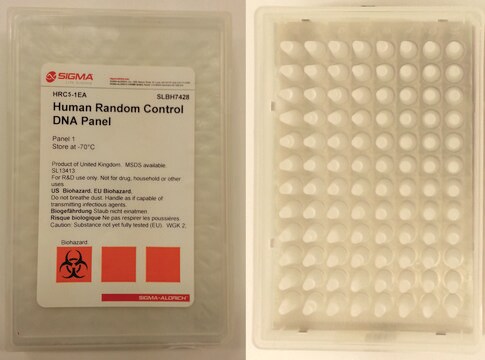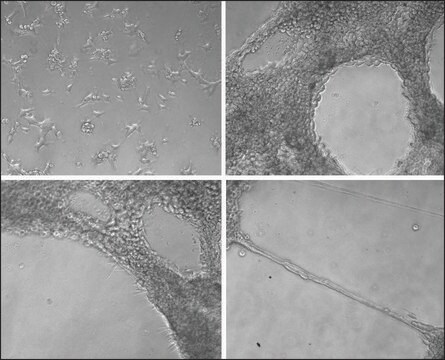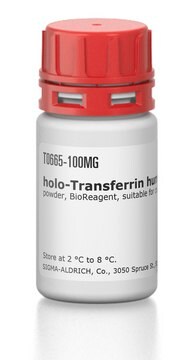About This Item
Produtos recomendados
Nível de qualidade
forma
liquid
concentração
100 ng/μL
cor
colorless
Condições de expedição
dry ice
temperatura de armazenamento
−70°C
Procurando produtos similares? Visita Guia de comparação de produtos
Categorias relacionadas
Aplicação
The range of Human Random Control (HRC) DNA samples represents a control population of 480 UK Caucasian blood donors. The HRC DNA is extracted from lymphoblastoid cell lines derived by Epstein Barr Virus (EBV) that can be continuously propagated in culture. This ensures an infinite supply of the unvarying DNA panels. The composition of each panel is completely defined and standardized so that each lot will be identical. Therefore, the HRC DNA Panels can be used as Reference Standards as routine quality control in the laboratory.
The purified HRC DNA is available in 5 different panels (HRC 1 through 5) consisting of 96 individuals with 2 μg each at a concentration of 100 ng/μL. The DNA is dissolved in 10 mM Tris (pH 8) 1 mM EDTA.
For ordering purposes, the 96-well plate format is listed as a 1 EACH (1EA) package size.
Palavra indicadora
Warning
Frases de perigo
Declarações de precaução
Classificações de perigo
Eye Irrit. 2
Código de classe de armazenamento
11 - Combustible Solids
Classe de risco de água (WGK)
WGK 2
Certificados de análise (COA)
Busque Certificados de análise (COA) digitando o Número do Lote do produto. Os números de lote e remessa podem ser encontrados no rótulo de um produto após a palavra “Lot” ou “Batch”.
Já possui este produto?
Encontre a documentação dos produtos que você adquiriu recentemente na biblioteca de documentos.
Os clientes também visualizaram
Artigos
DNA, RNA, cDNA derived from ECACC mammalian cell lines allow screening for genes or expression patterns to identify lines most suitable for specific research.
Nossa equipe de cientistas tem experiência em todas as áreas de pesquisa, incluindo Life Sciences, ciência de materiais, síntese química, cromatografia, química analítica e muitas outras.
Entre em contato com a assistência técnica










